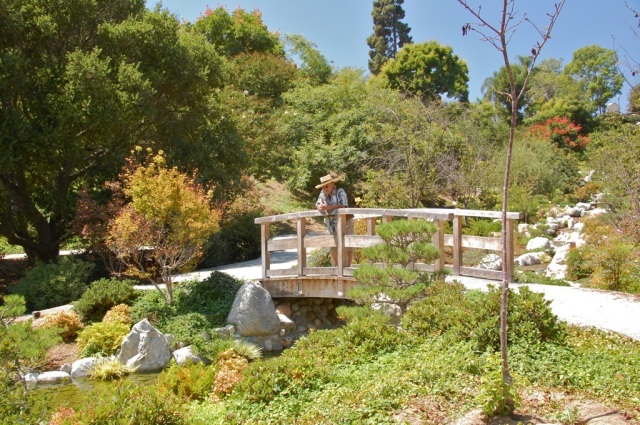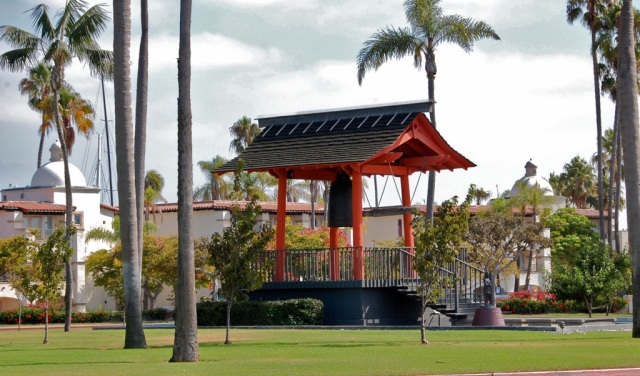Located in the heart of San Diego’s Balboa Park, the Japanese Friendship Garden is an oasis of serenity amidst a bustling city and its freeways. Per the “Japanese Friendship Garden of San Diego Visitor Guide,” this garden is named “San-Kei-En,” meaning “Three Scene Garden: Water, Pastoral and Mountain,” after the Sankei-en Garden in Yokohama, Japan, San Diego’s sister city. (Take a serene stroll through the Sankeien Garden in Yokohama.*)
Upon entering, we experience the sight and sound of the shishi-odoshi,* meaning “scare the deer,” originally a device used by farmers to scare away animals eating their crops. Listen to the Friendship Garden’s Audio Strolling Tour of the Upper Canyon (Open on a new tab/window).
Also seen above are Japanese garden elements of rocks (symbolizing mountains), bamboo fence, pathway, and horsetail rush, Equisetum hyemale. A short way down the path, we observed fig beetles having a festive time on an Indian hawthorn, Rhaphiolepis indica.
Another element of the Japanese garden is the ishidoro,* stone lantern, also known as oribe-doro and tōtō.
Below, are images of the water basin, tsukubai,* originally used to cleanse the hands before entering a place of ritual, such as a temple or tea house. “This process is thought to cleanse the spirit,” says our Visitor Guide brochure. The Japanese tea house* represents the values of lasting friendships and an enduring connection with nature.
We entered the Exhibit House and viewed a Japanese rock garden,* karesansui, through the windows. Gravel symbolizes water and the rocks symbolize mountains and islands.
Outside, in the upper garden, koi, symbol of longevity, swam and helped us relax.*
We paused at the Charles C. Dail Memorial Gate before proceeding to the lower garden. Per Wikipedia, San Diego Mayor Charles Dail was instrumental in establishing a sister-city relationship between San Diego and Yokohama, Japan (1957).
Passing through the gate, we descended down curved pathways (to “discourage evil spirits from entering the Garden,” per our guide) and passed Azalea and Camellia gardens* on the way to the Dragon Bridge, considered a symbol of power, strength, and good luck. Listen to the Friendship Garden’s Audio Strolling Tour of the Lower Canyon (Open on a new tab/window).
Crepe myrtle, Lagerstroemia, was blooming.
The Chinese Flame Tree, Koelreuteria bipinnata, displayed its red fruit, rose-pink, papery seed capsules, seen below.
The lower garden has several ponds, shishi-odoshi and bridges.
Bridges may provide an opportunity to experience anticipation of crossing to a new place* or an opportunity to pause and contemplate* or meditate on being in the moment.*
We eventually crossed over and visited the Inamori Pavilion, where special exhibits are displayed throughout the year, and is available for lectures and weddings.
Alaskan Yellow Cedar* was used for the posts and beams and is traditionally used in Japanese buildings because it is strong and can withstand the elements.
We continued on the winding garden paths while enjoying the play of shadows…
and paused at the Light of Friendship. This bronze lantern, a gift from the Boy Scouts and Yokohama citizens, has a chrome sphere inside containing the names of the people who helped send this gift to San Diego, and is a symbol of the continued friendship between San Diego and Yokohama.
We look forward to touring the Japanese Friendship Garden* in March, when the cherry trees* are blooming with profuse, pink flowers during the Cherry Blossom Festival.*
We also visited the Yokohama Friendship Bell on Shelter Island (San Diego), presented to San Diego by the citizens of Yokohama to San Diego in 1958 as part of the recognition of the San Diego – Yokohama sister city status and continues to promote peace & humanity.*
This 6-foot high, two ton bronze bell is inscribed with the words, “Bell of Friendship,” in English and Japanese, and is sounded by striking the side of the bell with the large horizontal wood ram, which occurs every New Year’s Eve (See and hear the bell).*
In the words of Thich Nhat Hanh*:
May the sound of this bell penetrate deep into the cosmos
Even in the darkest spots, living beings are able to hear it clearly, so that all suffering in them cease, understanding comes to their heart and they transcend the path of sorrow and death
Listening to the bell, I feel the afflictions in me begin to dissolve, my mind calm, my body relax, a smile is born on my lips
Following the sound of the bell, my breath brings me back to the safe island of mindfulness
In the gardens of my heart, the flowers of peace bloom beautifully
The Great Bell Chant (The End of Suffering)*
*This is a link to a YouTube video.






















See additional information and images in my posting “Japanese Friendship Garden of San Diego” on my sister blog, History Safari Express.
LikeLike
Wonderful photos. Intriguing information. I learn so much from your posts. I leave your site feeling peaceful. 🙂
LikeLike